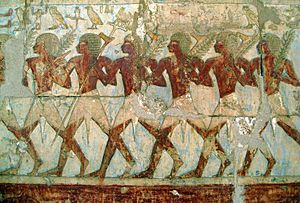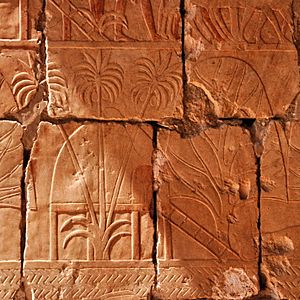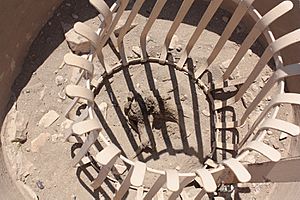Land of Punt facts for kids
The Land of Punt was a mysterious and rich place that ancient Egyptians traded with. They called it Pwenet or Pwene. It was known for its valuable goods like gold, sweet-smelling resins (like tree sap), blackwood, ebony, ivory (from elephant tusks), and even wild animals.
Egyptians started trading with Punt as early as 6,000 BC. They learned about this land from records of their many trade trips. Sometimes, Punt was also called Ta netjer, which means "Land of the God."
No one knows exactly where Punt was located. Most experts today think it was southeast of Egypt. This would be in the coastal areas of modern-day Somalia, Djibouti, Eritrea, northeast Ethiopia, and the Red Sea coast of Sudan. However, some experts believe it was in the Arabian Peninsula. It's also possible that Punt included both the Horn of Africa and Southern Arabia. The region in Somalia called Puntland might even be named after the ancient Land of Punt.
The people of Punt had different clothes and hairstyles. They raised cattle and lived in houses built on stilts. A trip from the Nile River to Punt by caravan could take about five days.
Contents
Egyptian Journeys to Punt
The first recorded Egyptian trip to Punt was led by Pharaoh Sahure around 2500 BC. But gold from Punt was in Egypt even earlier, during the time of Pharaoh Khufu.
More trips to Punt happened during the Sixth, Eleventh, Twelfth, and Eighteenth dynasties of Egypt. In the Twelfth Dynasty, trade with Punt was even mentioned in a popular story called Tale of the Shipwrecked Sailor.
During the Eighteenth Dynasty, Hatshepsut built a special fleet of ships for the Red Sea. This made it easier to trade with places as far south as Punt. She wanted to bring valuable goods to Karnak.
Queen Hatshepsut made the most famous Egyptian journey to Punt in the 15th century BC. Her ships regularly crossed the Red Sea to get things like bitumen, copper, and carved charms. They also brought back frankincense and myrrh.
A report of this five-ship journey can still be seen on the carvings in Hatshepsut's temple at Deir el-Bahri. The carvings show that Hatshepsut's leader, Chancellor Nehsi, traveled to Punt. He was supposed to collect gifts from the people there. But in reality, it was a simple trading trip. Punt was already a well-known trading place. Nehsi's trip was not very dangerous. He had at least five ships full of Egyptian soldiers. The chief of Punt and his family welcomed them warmly.
The people of Punt traded their own goods like incense, ebony, and cattle. They also traded goods from other African lands, such as gold, ivory, and animal skins. According to the temple carvings, King Parahu and Queen Ati ruled Punt at that time. This famous trip happened in the ninth year of Hatshepsut's rule. The god Amun blessed the journey:
Said by Amen, the Lord of the Thrones of the Two Land: 'Come, come in peace my daughter, the graceful, who art in my heart, King Maatkare [ie. Hatshepsut]...I will give thee Punt, the whole of it...I will lead your soldiers by land and by water, on mysterious shores, which join the harbours of incense...They will take incense as much as they like. They will load their ships to the satisfaction of their hearts with trees of green [ie. fresh] incense, and all the good things of the land.'
Egyptians were not very good at sea travel. For them, the journey to Punt was like modern explorers traveling to the moon. But the rewards, like frankincense, ebony, and myrrh, were worth the risks. Hatshepsut's successors, like Thutmose III and Amenhotep III, also continued trading with Punt. This trade lasted until the start of the 20th dynasty.
A document from the 20th dynasty, Papyrus Harris I, describes an Egyptian trip returning from Punt:
They arrived safely at the desert-country of Coptos: they moored in peace, carrying the goods they had brought. They [the goods] were loaded, in travelling overland, upon asses and upon men, being reloaded into vessels at the harbour of Coptos. They [the goods and the Puntites] were sent forward downstream, arriving in festivity, bringing tribute into the royal presence.
After the New Kingdom period ended, Punt became a legendary place, full of myths and stories.
What "Ta netjer" Means
The ancient Egyptians sometimes called Punt Ta netjer, which means "God's Land." This name came from the fact that Punt was in the direction of the sunrise, to the East of Egypt. These eastern lands provided goods used in temples, especially incense.
Some older writings suggested that "God's Land" meant Punt was the original homeland of the Egyptians. However, this idea is not widely accepted today. The term "God's Land" was also used for other eastern regions, like Lebanon, which provided wood for temples.
Where Was Punt Located?
The goods from Punt, as shown in Hatshepsut's temple, are common in the Horn of Africa. They are less common or missing in Arabia. Because of this, most experts think Punt was in Northeast Africa. These goods included gold and sweet-smelling resins like myrrh, frankincense, and ebony. The wild animals shown in Punt included giraffes, baboons, hippopotami, and leopards.
Richard Pankhurst said that Punt has been linked to both Arabian and African coasts. But he noted that the goods Egyptians got from Punt, like gold and ivory, were mostly from Africa. This makes him believe Punt was more likely in Africa than Arabia.
However, some experts disagree. Dimitri Meeks pointed out that some ancient writings place Punt in Arabia. He said that only the Arabian Peninsula fits all the descriptions of Punt being north, east, or southeast of Egypt, with its farthest borders to the south.
In 2010, scientists studied the mummified remains of baboons brought from Punt by the Egyptians. They used a special test on the baboons' hair. The results showed that the baboons most closely matched modern baboons from Eritrea and Ethiopia. The scientists did not test baboons from Yemen. They believed that baboons in Yemen would be similar to those in Somalia.
Professor Dominy, one of the lead researchers, thought that Punt was a specific area including eastern Ethiopia and all of Eritrea. In 2015, more studies confirmed these findings. They concluded that Punt was likely in eastern Somalia and the Eritrea-Ethiopia area. This suggests that this region was where the baboons came from.
Egyptian spelling "pwenet" (The "t" ending was not pronounced during the New Kingdom.) The last sign means country or land. |
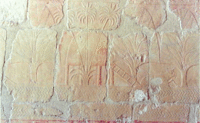 Wall carving |
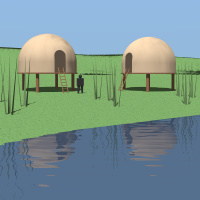 Huts like those in the carving |
Images for kids
See also
 In Spanish: Punt para niños
In Spanish: Punt para niños


